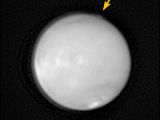By now, astronomers are quite familiar with Mars, what with all the rovers and orbiters busy exploring this cosmic neighbor of ours. Still, it looks like the Red Planet still has plenty of secrets scientists are yet to decipher.
For instance, brainiacs with the European Space Agency admit that, although they have until now had the chance to study them on several occasions, they still have no idea what some seriously bizarre plumes that every once in a while rise on Mars might be.
The plumes, pictures of which are included in the gallery below, usually take about 10 hours to form. The majority of them soar to an altitude of some 100 kilometers (roughly 62 miles) and hover over the planet for around 10 days before disappearing.
However, in March and in April 2012, astronomers got to see such peculiar structures rising to an altitude of about 250 kilometers (approximately 155 miles) above the Red Planet's surface. How and why these plumes reached such an impressive height remains a mystery.
As mentioned, scientists are clueless about what these plumes are and how exactly they form. Some say that they most likely comprise water-ice, carbon dioxide-ice or dust particles that got together to form clouds, but this is yet to be confirmed.
“One idea we’ve discussed is that the features are caused by a reflective cloud of water-ice, carbon dioxide-ice or dust particles, but this would require exceptional deviations from standard atmospheric circulation models to explain cloud formations at such high altitudes,” says astronomer Agustin Sanchez-Lavega.
Astronomers with the European Space Agency expect that, after the ExoMars Trace Gas Orbiter is launched in 2016 and reaches the Red Planet, they will finally have enough data to work with to solve this puzzle once and for all.

 14 DAY TRIAL //
14 DAY TRIAL // 


